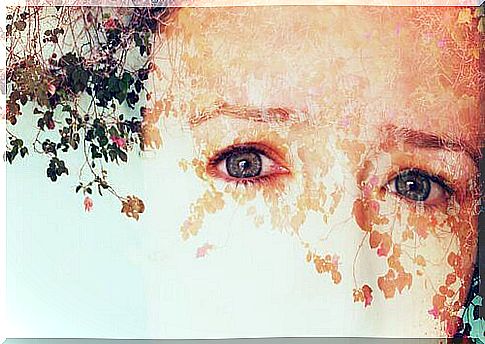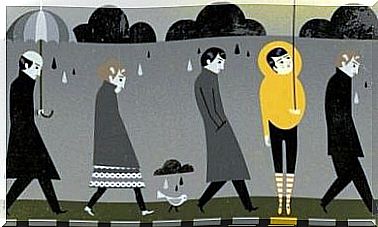Maladaptive Daydreams: When You Daydream Too Much

Maladaptive daydreams are a sign of a strange syndrome. The person who suffers from it spends much of their time engrossed in a fantasy world and completely disconnected from reality. Although we all daydream, there are some who exaggerate it. This exaggerated daydreaming isolates them and they may even begin to neglect their real lives such as food, responsibilities and relationships.
When we talk about syndromes, you may feel startled. Perhaps you feel that we are beginning to see pathology in quite ordinary behavior. Here we will just state that any kind of behavior will begin to be analyzed from a clinical perspective as soon as it begins to disturb the person in their ordinary daily life.
When a person uses his fantasies and dreams to isolate himself from reality for hours or to escape from emotional conflict and trauma until they neglect themselves, then we are dealing with psychological pathological behavior.
Daydreaming is therefore not a problem in itself. As long as we can also have a fully functional day. 95% of the population belongs to this category. After all, we all fantasize, and through our imagination, we activate infinite areas of the brain that improve our mental agility. So structures such as the prefrontal cortex, the limbic system, and various other areas of the brain that deal with sensory information. It helps us reflect on different areas of life, gives us new motivation for our projects and gives good mood.
Typically, daydreams are brief moments in our day that act as a mental “reset”. They are instant refuge that helps our well-being. But the real problem arises when we prefer these private worlds over our real lives. In fact, there are usually other underlying, related issues at play when we talk about maladaptive daydreams. It can include trauma, obsessive-compulsive disorder or OCD, underlying conflicts…

Exaggerated or maladaptive daydreams: How to recognize the disease
The disorder of maladaptive daydreams are not (yet) registered in the diagnostic manual of mental disorders ( Diagnostic and Statistical Manual of Mental Disorders , or DSM-V in English). It is expected to be written into future editions as more research is done into the disorder and new therapeutic approaches to it. It was actually in 2002 that psychiatrist Eliezer Somer from the University of Haifa in Israel first started talking about it. He gave it his name and described the associated symptoms.
Symptoms include the following:
- These patients are dreamers; dreamers who are able to create their own characters and be engrossed in complex, detailed and very vivid stories.
- These fantasies disrupt their real lives. Anything they are exposed to in everyday life can trigger a new story. A new internal narrative that they can immerse themselves in without taking care of what they were doing at the moment.
- They neglect their responsibilities, including food and hygiene.
- They have difficulty sleeping at night.
- When awake, they usually perform repeated or locked movements, including their facial expressions.
- They usually speak softly and mumbling over the course of their fantasies, the staging of their own dreaming.
- These fantasies can last for hours. When they quit and bring about a return to reality, they experience a high degree of anxiety, as with any addiction.

What is happening behind the maladaptive daydreams?
As we have mentioned, this disorder is still being described and analyzed. But there are many psychiatrists and psychologists who treat their patients with this on a daily basis. We can also see that new articles are frequently published to update research and theoretical approaches. So we understand this disorder more and more, and professional practice confirms the information we already have.
Maladaptive daydreams never occur alone. Other disorders or underlying problems usually lead to it. They are as follows:
- People who have suffered from abuse or experienced other forms of traumatic experiences during their lives.
- Patients with depression may also show symptoms of maladaptive daydreaming.
- Obsessive-compulsive disorder.
- Borderline personality disorder.
- It has also been observed in people with some form of autism.
Treatment of maladaptive daydreams
The professional trainee working with the patient suffering from maladaptive daydreams will first try to find out exactly what the underlying cause of the disorder is. The therapeutic treatment will not be the same for someone with depression as for a person with obsessive-compulsive disorder. It is the challenge and the starting point to treat this disorder.
It is also interesting to know that the psychiatrist, Eliezer Somer, developed a scale from which to diagnose this clinical condition. The “maladaptive daydreaming scale (MDS)” has 14 scales that can be used to define this disorder. It has been used to distinguish this condition from other mental disorders such as schizophrenia and psychosis.
In addition, the psychotherapeutic technique EMDR (Eye Movement Desensitization and Reprocessing) has been successful . It demonstrates a high degree of success in the treatment of this disorder. It is an interesting approach to solve the emotional problems caused by traumatic experiences. It was invented in 1987 by Francine Shapiro.

There has been similar success with cognitive behavioral psychology, which is also an effective form of treatment. This therapy has the following goals:
- To connect the person with reality.
- To encourage regulated activities and time control.
- To identify stimuli in everyday life that trigger daydreams.
- To improve attention.
- To promote a healthy lifestyle.
- To promote the interests of the patient that integrates them into everyday life.
To conclude, it is important to know when certain types of behavior take us away from our responsibilities and our ability to enjoy a perfect, happy, and responsible life. Excessive daydreaming can sometimes be like an addictive “substance” we use to isolate ourselves from reality that inflicts pain on us or in which we can find no meaning.









